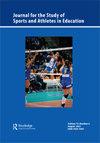Relationship between social support and depressive symptoms in collegiate student athletes
IF 1
Q3 EDUCATION & EDUCATIONAL RESEARCH
Journal for the Study of Sports and Athletes in Education
Pub Date : 2020-05-21
DOI:10.1080/19357397.2020.1768034
引用次数: 19
Abstract
ABSTRACT Depression levels in collegiate athletes are consistent with or higher than those of the general population [Cox (2015). Investigating the prevalence and risk-factors of depression symptoms among NCAA Division I collegiate athletes (Doctoral dissertation, Southern Illinois University at Edwardsville); Prinz, Dvořák, & Junge (2016). Symptoms and risk factors of depression during and after the football career of elite female players. British Journal of Medicine and Sport Open Sport & Exercise Medicine, 2(1), e000124; Wolanin, Hong, Marks, Panchoo, & Gross (2016). Prevalence of clinically elevated depressive symptoms in college athletes and differences by gender and sport. British Journal of Sports Medicine, 50(3), 167–171], warranting examination of probable causes and protective factors. This study examined depressive symptoms in collegiate athletes and how they relate to different types and sources of social support. The student athlete population at a Division I university (N = 238) completed a survey on depressive symptoms (i.e., Center for Epidemiological Studies Depression Scale) [CES-D; Radloff (1977). The CES-D scale. Applied Psychological Measurement, 1(3), 385–401] and social support (i.e., Berlin Social Support Scale; [BSSS; Schulz & Schwarzer (2003). Soziale Unterstützung bei der Krankheitsbewältigung. Die Berliner social support Skalen (BSSS) [Social support in coping with illness: The Berlin social support scales (BSSS)]. Diagnostica, 49(2), 73–82]four open-ended questions). Higher levels of social support were correlated with fewer depressive symptoms. Multiple regression revealed tangible support from athletic sources, need for support, and tangible support from personal sources were significant predictors of depressive symptoms, (F = 23.2, p <.001). Most beneficial soources of support were teammates (n=20) and non-athletic persons (n=19). Athletes wanted more support from coached (n=72). This study offers insight into how best to provide support, which impacts performance and overall mental health.大学生运动员抑郁症状与社会支持的关系
摘要大学生运动员的抑郁水平与普通人群一致或高于普通人群[Cox(2015)。NCAA第一赛区大学生运动员抑郁症状的患病率和风险因素调查(博士论文,南伊利诺伊大学爱德华维尔分校);Prinz,Dvořák,&Junge(2016).精英女球员足球生涯期间和之后的抑郁症症状和危险因素。英国医学与运动杂志《开放运动与运动医学》,2(1),e000124;Wolanin,Hong,Marks,Panchoo和Gross(2016)。大学运动员临床上抑郁症状升高的患病率及性别和运动的差异。《英国运动医学杂志》,50(3),167-171],保证对可能的原因和保护因素进行检查。这项研究调查了大学生运动员的抑郁症状,以及它们与不同类型和社会支持来源的关系。一级大学的学生运动员人数(N = 238)完成了一项关于抑郁症状的调查(即流行病学研究中心抑郁量表)[CES-D;Radloff(1977)。CES-D量表。应用心理测量,1(3),385-401]和社会支持(即柏林社会支持量表;[BSS;Schulz&Schwarzer(2003)。Soziale Unterstützung bei der Krankheitsbewältigung.Die Berliner社会支持Skalen(BSSS)[应对疾病的社会支持:柏林社会支持量表(BSSS)]。Diagnostica,49(2),73–82]四个开放式问题)。社会支持水平越高,抑郁症状越少。多元回归显示,来自运动来源的有形支持、对支持的需求和来自个人来源的有形支助是抑郁症状的显著预测因素,(F = 23.2,p<.001)。最有益的支持来源是队友(n=20)和非运动型人士(n=19)。运动员希望得到教练的更多支持(n=72)。这项研究深入了解了如何最好地提供支持,这会影响表现和整体心理健康。
本文章由计算机程序翻译,如有差异,请以英文原文为准。
求助全文
约1分钟内获得全文
求助全文
来源期刊

Journal for the Study of Sports and Athletes in Education
EDUCATION & EDUCATIONAL RESEARCH-
自引率
0.00%
发文量
25
 求助内容:
求助内容: 应助结果提醒方式:
应助结果提醒方式:


